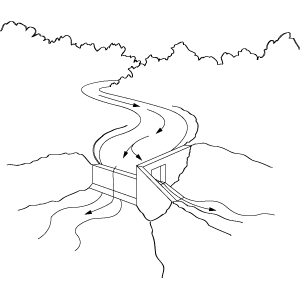| Diverting the
Flows
What good is a new stream channel without water? Not much, except that it would
give new vegetation a chance to become established. In the case of the new channel for the East
Branch of Haig-Brown Kingfisher Creek, water is available, but obstacles exist in diverting it
into the new creek branch. The design of a successful diversion structure must accomplish
several tasks. For instance, it must divert even the lowest water flows to the new creek channel,
while providing a fail-safe overflow in times of very high water. Also, the diversion structure
must not get clogged with debris, it must allow salmon to migrate past the structure, and above
all, it must stand up to the test of time. The task of developing this diversion structure for the
new channel in Haig-Brown Kingfisher Creek has been contracted out to our design team:
engineers from Highland Engineering, landscape architects from Lanarc Consulting, and
consulting biologists from GB. Vardy Biological Consulting.
The proposed diversion, as presented by Richard Stephens of Highland Engineering,
is a low flow diversion structure. Under normal conditions it will allow all waters from
Haig-Brown Kingfisher Creek's east branch to be diverted into the newly created channel.
However, during floods, excess water will spill over a connected dyke wall and flow down its
old course into the city's storm drains.
|
The proposed design is essentially a concrete V with one side lower than the other.
On the taller side, a hole in the wall sits at ground level and diverts the incoming water into the
new channel. Once this hole is full, floodwaters will spill over top of the lower wall into the
city's storm system. Flood conditions of 500 litres/second would be the maximum flow rate into
the new channel.

Map of water diversion
Because of the major flooding that has historically plagued Campbellton Elementary
and the Willow St. area residents, it is important to have this diversion just right. Additional
precautions to minimize flooding threats include:
- a long dyke starting after the diversion structure,
- a new berm along the Campbellton Elementary field,
- an overflow diversion structure at the existing culvert under the school field,
- and the removal or enlargement of existing culverts.
Of course, like everything else, these plans are subject to modification if desirable alternatives
present themselves.
Top of page.
|

